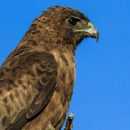In January 2020, the U.S. Fish and Wildlife Service published a final rule removing the ‘io (Hawaiian hawk) from the Federal List of Endangered and Threatened Wildlife. The ‘io was listed in 1967. Since then, improved monitoring, partner-led landscape-level conservation efforts and the species’ demonstrated resilience now indicate it no longer meets the definition of threatened or endangered.
Species Spotlight: Hawaiian Hawk
Scientific Name: Buteo solitarius
Hawaiian Name: ‘Io
Status: Delisted Due to Recovery
Click here to read the Listing and Recovery documents.
In Hawaiian culture, ‘io are aumakua – a family or personal god. This graceful bird of prey measures 16 to 18 inches in length, the female being larger. Two color phases exist: a dark phase (dark brown head, breast, and underwings), and a light color phase (dark head, light breast and light underwings). Feet and legs are yellowish in adults and greenish in juveniles.
Habitat and Range
Currently, the hawk is known to breed only on the island of Hawai‘i, but there have been at least eight observations of the species on the islands of Kaua‘i, O‘ahu, and Maui since 1978, and fossils are known from the islands of Moloka‘iand Kaua‘i.
The current range of the hawk is estimated to encompass 2,372 square miles, comprising 58.7 percent of the island of Hawai‘i. ‘Io are quite territorial and will vigorously defend the areas around their nest and hunting range.
They have been known to nest in a variety of native and non-native habitats, but they can be found in much higher densities and have higher reproductive success in native ‘ōhi‘a forests.
Diet and Life Cycle
‘io begin breeding around age 3 or 4 and will mate for life. The males will perform acrobatic courtship displays that can be seen from winter through the spring, when nesting season begins. The pair begins nest building in the spring and continues until the females lay their clutch usually of 1-2 eggs.
Egg laying begins in March and hatching is typically done by July. Both parents help with incubating the egg for 38 days, but once the chick has hatched the male primarily hunts while the female broods.
The ‘io is an opportunistic feeder, and will hunt a wide variety of prey. Prior to the introduction of land mammals to the islands, the ‘io probably hunted birds as their main source of food. Today rats, mice, mongoose and various bird species are all significant parts of the ‘io diet.
‘Io hunt and nest in a wide variety of habitats. While they generally prefer dense native forests, they are also frequently seen in agricultural areas as well.
Threats to the Species
The Hawaiian Hawk was listed as endangered in 1967. Since that time the population has remained low, but relatively stable. However, habitat loss due to invasive plants and the spread of rapid ‘ōhi‘a death continue to be a threat to the species.
Conservation Efforts
The establishment of the Hakalau Forest National Willife Refuge (north Hilo region) in 1985, the Kona Forest Unit of the Hakalau Forest NWR in 1997, and The Nature Conservancy’s Kona Hema Preserve (south Kona region) between 1999 and 2003 have all added important protected habitat for the ‘io.

